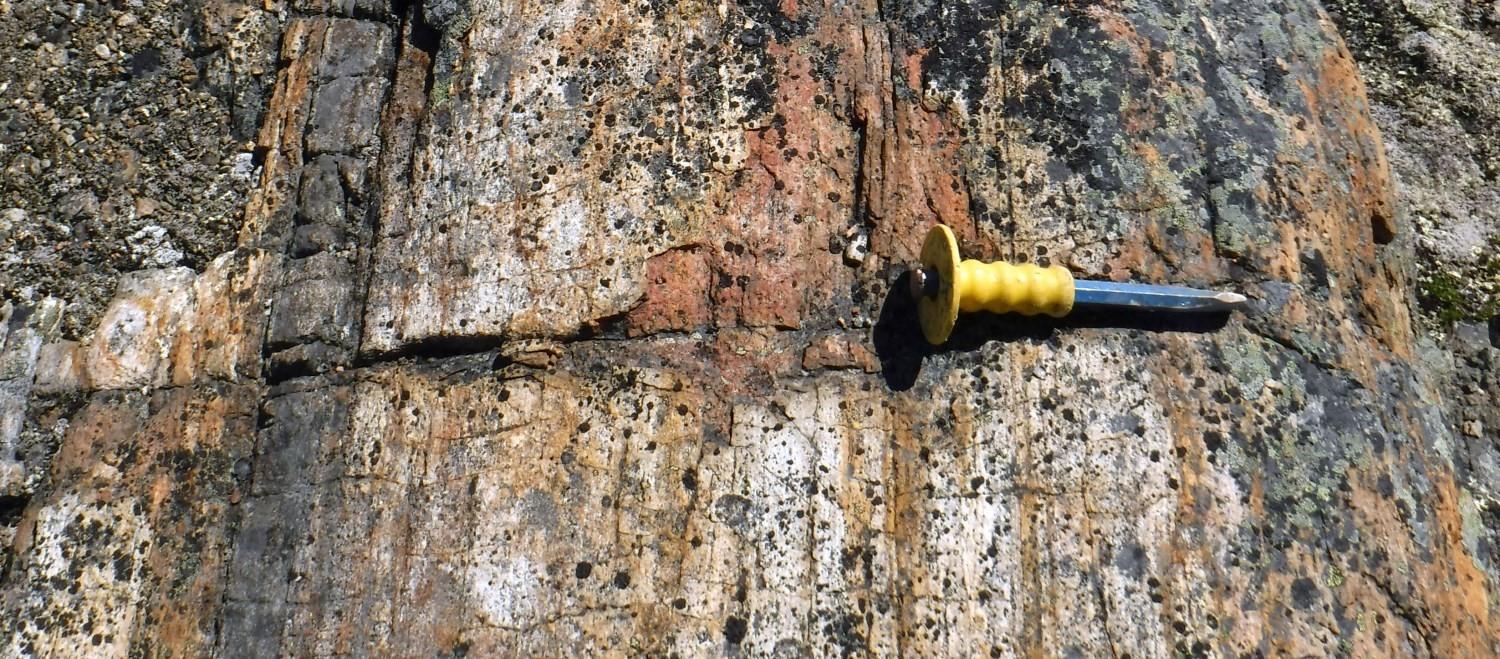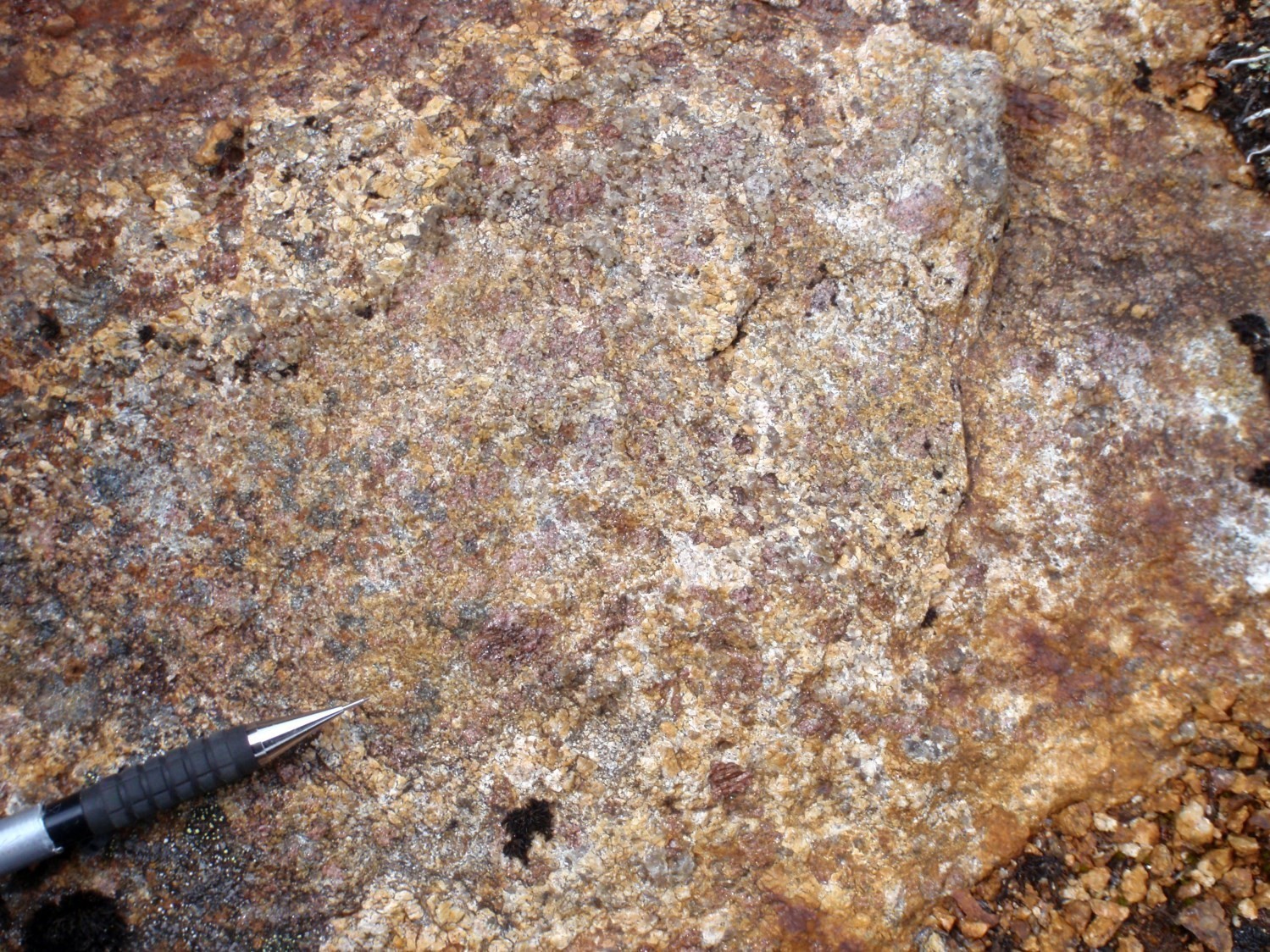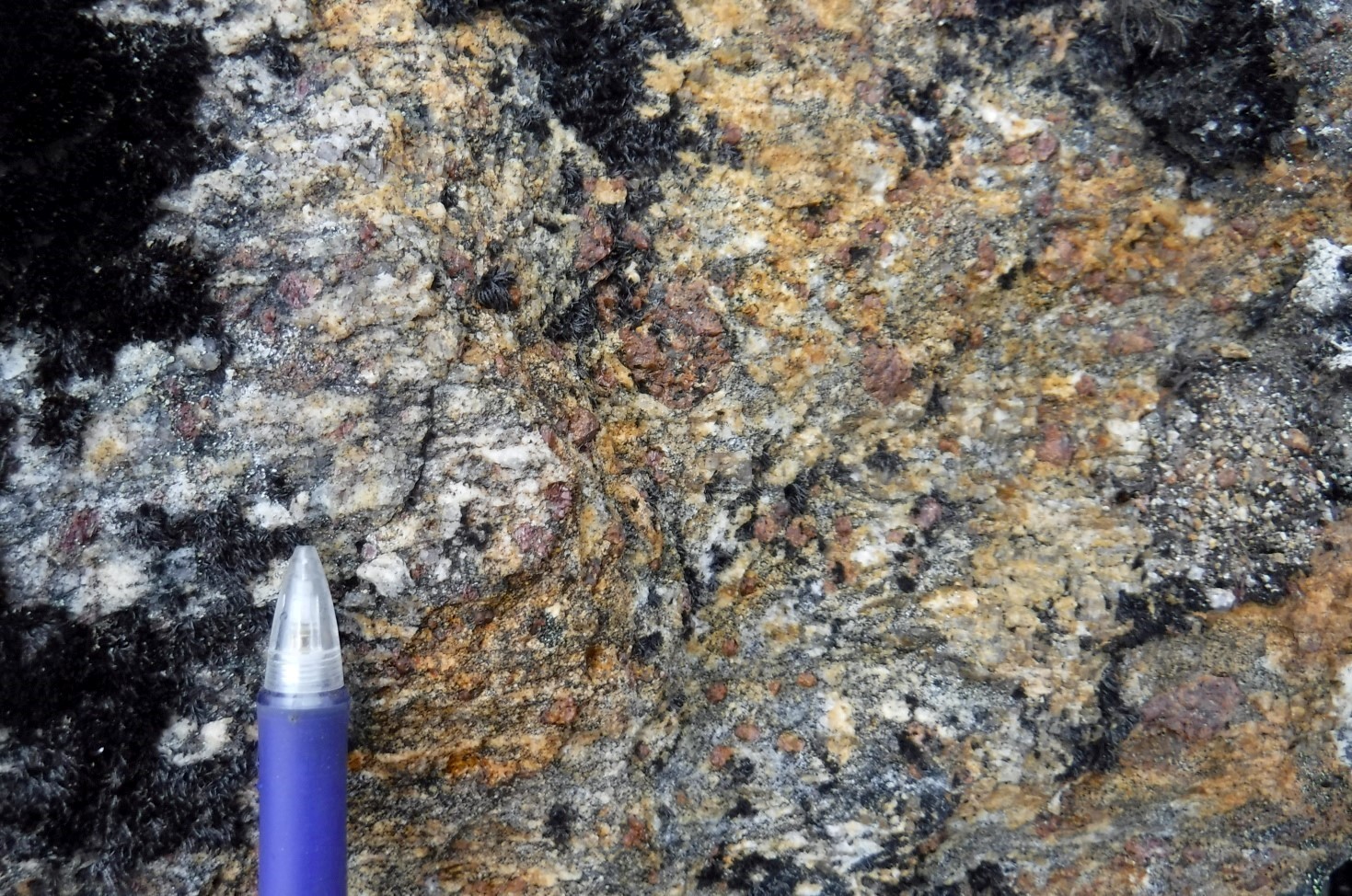
DISCLAIMER: This English version is translated from the original French. In case of any discrepancy, the French version shall prevail.
| Author(s): | Girard, 1990 |
| Age: | Paleoproterozoic |
| Stratotype: | None |
| Type area: | Courdon Lake area (NTS sheet 14E) |
| Geological province: | Churchill Province |
| Geological subdivision: | Falcoz Lithotectonic Domain |
| Lithology: | Metamorphosed supracrustal rocks |
| Category: | Lithodemic |
| Rank: | Suite |
| Status: | Formal |
| Use: | Acive |
- Lomier Complex
-
- Koroc River Suite
- Courdon Intrusive Suite
Background
The term «Koroc River Group» was first used by Hoffman (1988) to group sequences of supracrustal rocks currently assigned to the Lake Harbour Group (pPhb) in the Koroc River area (NTS sheet 24I). Girard (1990) also used the term Koroc River Group to refer to rocks of supracrustal origin in the Courdon Lake area (sheet 14E) as an extension of supracrustalvolcano-sedimentary sequences of the Koroc River area. Because of a difficult correlation between the two units, Verpaelst et al. (2000), Lafrance et al. (2015), and Mathieu et al. (2018) preferred to maintain the use of the term «Koroc River Group», as used by Girard (1990), for the supracrustal sequences located between the Pilliamet Shear Zone (ZCpil) to the west and the Abloviak Shear Zone (ZCabl) to the east.
Given the degree of metamorphism and loss of primary structures, the use of the term «group» is inappropriate. The unit was renamed «Koroc River Suite» by Lafrance and Vanier (2022) as part of a synthesis of the southeastern Churchill Province (SEPC; Lafrance et al., 2018) to be consistent with North American Stratigraphic Code (NACSN, 1983, 2005) nomenclature. The lithodemic units included in this suite were also revised across the Falcoz Lithotectonic Domain by Lafrance and Vanier (2022). The table below summarizes the equivalences between the current and previous units.
|
Revised Units and Subunits (Lafrance et al., 2015; Mathieu et al., 2018; Lafrance and Vanier, 2022) |
Previous Units and Subunits |
Reference(s) |
|
pPko1 |
M16C; M16 GT |
Girard, 1990 |
|
pPko1a |
M16 |
Girard, 1990 |
|
pPlom3 |
Verpaelst et al., 2000 |
|
|
pPko2 |
M4 |
Girard, 1990 |
|
pPko3 |
M14 |
Girard, 1990 |
|
pPko4 |
M(S9) |
Girard, 1990 |
Description
Girard (1990) defined the Koroc River Group as an irregular succession of aluminous paragneiss and amphibolite with a lesser amount of iron formation, marble, calcosilicate rocks, quartzite and quartzofeldspathic rocks similar to those of the Courdon Intrusive Suite. The Koroc River Suite consists of four units: 1) an amphibolite unit (pPko1); 2) a paragneiss and leucogneiss unit (pPko2); 3) a marble and calcosilicate rock unit (pPko3); and 4) a sulphide-facies iron formation unit (pPko4). The description of these units is mostly taken from Girard (1990).
Koroc River Suite 1 (pPko1): Hypersthene Amphibolite
The amphibolite occurs as metric to kilometric horizons or sequences interbedded in other units of the Lomier Complex (pPlom). The rock is grey, fine grained, even grained, granoblastic and weakly foliated. It is predominantly composed of green hornblende in association with clinopyroxene (augite) that it replaces. The amphibolite also contains hypersthene and is characterized by the presence of plagioclase centimetric lenses (leucosome) with hypersthene, augite and/or hornblende porphyroblasts. Red garnet of rounded habitus is observed locally in association or as inclusion in pyroxene aggregates. Its abundance is locally close to 2%. The accessory mineral assemblage consists of reddish brown biotite, zircon, apatite and globulous epidote in plagioclase.
Koroc River Suite 1a (pPko1a): Amphibolite
The pPko1a subunit differs from the pPko1 unit only in the absence of hypersthene. In the western sector of sheet 14E12, a retromorphosed amphibolite sequence occurs in the vicinity of the ZCpil, in a granitic gneiss zone of the Lomier Complex also lacking orthopyroxene (pPlom2).
Koroc River Suite 2 (pPko2): Paragneiss and Leucogneiss

 The pPko2 unit consists of horizons of variable width, extending over several kilometres in length in the Lomier Complex. Their rusty patina and gossan strings that are easily spotted in the field make them a lithological marker for defining the structural grain of the region. Girard (1990) describes several lithofacies that are entangled in this unit and that are not distinguished on the map; aluminous paragneiss, ferro-aluminous paragneiss, quartzite and leucogneiss. The paragneiss are variably migmatized and locally contain leucosome in clusters and diffuse ribbons.
The pPko2 unit consists of horizons of variable width, extending over several kilometres in length in the Lomier Complex. Their rusty patina and gossan strings that are easily spotted in the field make them a lithological marker for defining the structural grain of the region. Girard (1990) describes several lithofacies that are entangled in this unit and that are not distinguished on the map; aluminous paragneiss, ferro-aluminous paragneiss, quartzite and leucogneiss. The paragneiss are variably migmatized and locally contain leucosome in clusters and diffuse ribbons.
Aluminous paragneiss has a predominantly quartzofeldspathic paragenesis with purple poikiloblastic garnet, fibrous sillimanite, brown biotite and pyrrhotite. Quartz is a significant proportion (40-80%) and forms rods with undulatory extinction in a microcline and plagioclase matrix with indented grain edges. Orthopyroxene is observed locally.
Ferro-aluminous paragneiss has <50% quartz and feldspar, and is dominated by cordierite accompanied by garnet, prismatic and locally poikiloblastic sillimanite, brown biotite and pyrrhotite. Zircon, apatite (scarce), ouvarovite, picotite and hercynite (especially in the core of garnet and sillimanite), as well as scarce grains of hypersthene and augite, compose the accessory mineral assemblage. Scapolite, sphene and allanite with epidote core are the secondary minerals. Garnet is granular to globulous, rich in inclusions (biotite, pyrrhotite, sillimanite, quartz and feldspar), rounded, flattened or stretched in the tectonic grain. It forms polymineralic aggregates with sillimanite, biotite and accessory minerals. Quartz is variable in proportion (locally very low) and forms zones and bands as well as droplets and scarce myrmekites in feldspar. K-feldspar can be either absent or abundant in the rock. All minerals show a granoblastic texture. However, late deformation commonly makes intergrowing or granulated grain edges, polydomanial or undulatory extinctions, and deformed twin networks. Quarzite horizons generally contain finely disseminated sulphides and graphite. Although evidence of partial melting is not readily distinguishable in outcrop, Charette et al. (2021) mention that garnet may contain optically continuous inclusions with edges along its crystal faces, suggesting that they correspond to pseudomorphs of anatectic fluid and that garnet growth therefore occurred in suprasolidus conditions.
Leucogneiss is poor in ferromagnesian minerals, which consist of biotite (<2%), garnet and opaque minerals. This leucogneiss is located mainly in the eastern portion of the Lomier Complex. It is granoblastic to saccharoidal. Paragneiss contains 20-60% decimetric to metric subconformable horizons of whitish trondhjemite (leucogranitoid), which could be derived from partial melting of paragneiss (Girard, 1990). These horizons are locally pegmatitic but usually medium grained. They contain ~30% quartz, 55% plagioclase and <5% biotite. Antiperthites develop in plagioclase for a total of 5% except within grains that have undergone dynamic recrystallization. Deformation is generally moderate and the intrusive appearance is preserved.
Koroc River Suite 3 (pPko3): Marble and Calcosilicate Rocks
Unit pPko3 occurs as metric horizons measured over several kilometres along tectonic grain. These rocks are stretched in deformation corridors, in association with gneiss of the Lomier Complex. They are more abundant and less deformed in sheet 14E13. Marble, which exhibits marked differential erosion, is generally exposed in valley troughs and on cliff sides. Foliation, which is very circumvented, is defined by alternating carbonate and calcosilicate horizons. The marble is granoblastic and is composed of calcite, scapolite, vesuvianite and diopside with, in lesser proportions, quartz, feldspar, biotite and sphene. Brecciated textures are common and are characterized by rounded calcosilicate aggregates floating in a matrix of fine-grained carbonates. Calcosilicate facies with diopside and plagioclase are associated with these breccias.
Koroc River Suite 4 (pPko4): Sulphide-Facies Iron Formation
Unit pPko4 represents a single area (sheet 14E12) consisting of small sulphide-facies iron formation lenses in amphibolites and paragneisses of the Koroc River Group. Iron formation has a brecciated to nebulitic texture in which rounded silicate fragments, millimetric to centimetric, float in a matrix of massive and granoblastic pyrrhotite (<40%). Fragments consist mainly of granoblastic plagioclase but also adjacent quartzofeldspathic rocks. Biotite grows at the interface between fragments and sulphides. There is strong surface alteration of bird’s eye pyrrhotite composed of marcasite and pyrite. Trace chalcopyrite shows mutual relationships on the edge of pyrrhotite grains or is remobilized in thin fractures within silicate phases. Pentlandite forms rare exsolutions in pyrrhotite while isolated sphalerite grains are dispersed in silicates.
Thickness and Distribution
The Koroc River Suite forms continuous horizons over kilometres, of variable width, but generally hectometre wide, in the Lomier Complex. It covers a limited area of ~84 km2 in the eastern part of the Falcoz Lithotectonic Domain, with the pPko2 unit (~63 km2) being the largest. The Koroc River Suite is bounded by the ZCpil to the west and the ZCabl to the east. In the northern part of the Falcoz Lithotectonic Domain, the ZCpil meets the ZCabl, which bifurcates in a NW-SE orientation (rather than N-S in the rest of the domain). In this area, the Koroc River Suite is thus bounded to the southwest by the ZCabl.
Dating
Three detrital zircons from the Koroc River Suite paragneiss (outcrop 2013-BC-6210) were analyzed. The ages range from 2447 Ma to 2039 Ma (Charette et al., 2021), the latter corresponding to the deposition maximum age. Zircons dated around 1845 Ma are interpreted by Charette et al. (2021) as having recorded anatectic liquid crystallization. These authors also dated garnet by the Lu-Hf method at ~1956 Ma, which represents the maximum age of garnet growth.
|
Unit |
Sample Number |
Isotopic System |
Mineral |
Detrital Age (Ma) |
Metamorphic Age (Ma) |
(+) |
(-) |
Reference(s) |
|
pPko2 |
U-Pb |
Zircon |
2447 to 2039 |
1845 |
4 |
4 |
Charette et al., 2021 |
|
|
Monazite |
1845 |
7 |
7 |
|||||
|
Lu-Hf |
Garnet |
1956 |
19 |
19 |
||||
|
Sm-Nd |
Garnet |
1784 |
31 |
31 |
Stratigraphic Relationship(s)
The transitional and diffuse contact of the Courdon and Koroc River suites with the Lomier Complex gneisses led Girard (1990) to consider the gneisses as more deformed areas of the units of these two suites.
The origin of the Lomier Complex is currently enigmatic (Wardle et al., 1990 and 2002; Lafrance et al., 2016; Corrigan et al., 2018; Charette et al., 2021), representing a significant gap in the geodynamic evolution of the region (Charette, 2016). It could be an equivalent of the Cumberland batholith on Baffin Island (St-Onge et al., 2009; Wardle et al., 2002), and thus be interpreted as the root of a magmatic arc emplaced at the eastern margin of the Falcoz lithotectonic Domain (Ermanovics and Van Kranendonk, 1998). However, the most accepted hypothesis is that it represents a continental arc related to eastward subduction of the Falcoz Domain beneath the Nain Province (Van Kranendonk and Wardle, 1996; Wardle et al., 2002).
The Koroc River Suite units also form dismembered horizons in gneisses of the Lomier Complex. Although the amphibolite sequences (pPko1) are commonly associated with the paragneisses of the pPko2 unit, suggesting a supracrustal origin, Girard (1990) mentions that they may also have a link to mafic rocks of the Courdon Intrusive Suite (pPcou2) with which they show gradual contacts locally. In other places, supracrustal rocks of the Koroc River Suite are cut by rocks of the Courdon Intrusive Suite (Girard, 1990).
Paleontology
Does not apply.
References
Publications Available through SIGÉOM Examine
GIRARD, R., 1990. GEOLOGIE DE LA REGION DU LAC COURDON – TERRITOIRE DU NOUVEAU-QUEBEC. COMMISSION GEOLOGIQUE DU CAN; MB 90-24, 65 pages, 1 plan.
LAFRANCE, I., BANDYAYERA, D., BILODEAU, C., 2015. GEOLOGIE DE LA REGION DU LAC HENRIETTA (SNRC 24H). MERN; RG 2015-01, 62 pages, 1 plan.
LAFRANCE, I., BANDYAYERA, D., CHARETTE, B., BILODEAU, C., DAVID, J., 2016. Géologie de la région du lac Brisson (SNRC 24A). MERN; RG 2015-05, 64 pages, 1 plan.
LAFRANCE, I., CHARETTE, B., VANIER, M.-A., 2018. Sud-est de la Province de Churchill, Nunavik, Québec, Canada: synthèse de la géologie. MERN; BG 2018-12
LAFRANCE, I., CHARETTE, B., VANIER, M.-A., 2018. Southeastern Churchill Province, Nunavik, Quebec, Canada: Geological Synthesis. MERN; BG 2018-12
LAFRANCE, I., VANIER, M.-A., 2022. Domaine lithotectonique de Falcoz, sud-est de la Province de Churchill, Nunavik, Québec, Canada : synthèse de la géologie. MERN; BG 2022-01, 2 plans.
MATHIEU, G., LAFRANCE, I., VANIER, M.-A., 2018. Géologie de la région de pointe Le Droit, Province de Nain et sud-est de la Province de Churchill, Nunavik, Québec, Canada. MERN; BG 2018-07, 4 plans.
MATHIEU, G., LAFRANCE, I., VANIER, M.-A., 2018. Geology of the Pointe Le Droit Region, Southeastern Churchill Province, Nunavik, Quebec, Canada. MERN; BG 2018-07, 4 plans.
VERPAELST, P., BRISEBOIS, D., PERREAULT, S., SHARMA, K. N. M., DAVID, J., 2000. Géologie de la région de la rivière Koroc et d’une partie de la région de Hébron, 24I et 14L. MRN; RG 99-08, 62 pages, 10 plans.
Other Publications
CHARETTE, B., 2016. Long-lived anatexis in the exhumed middle crust from the Torngat Orogen and Eastern Core Zone: Constraints from geochronology, petrochronology, and phase equilibria modeling. University of Waterloo; thèse de maîtrise, 418 pages. https://uwspace.uwaterloo.ca/handle/10012/10453
CHARETTE, B., GODET, A., GUILMETTE, C., DAVIS, D.W., VERVOORT, J., KENDALL, B., LAFRANCE, I., BANDYAYERA, D., YAKYMCHUK, C., 2021. Long-lived anatexis in the exhumed middle crust of the Torngat Orogen: Constraints from phase equilibria modeling and garnet, zircon, and monazite geochronology. Lithos; volume 388-389. doi.org/10.1016/j.lithos.2021.106022
CORRIGAN, D., WODICKA, N., McFARLANE, C., LAFRANCE, I., VAN ROOYEN, D., BANDYAYERA, D., BILODEAU, C. 2018. Lithotectonic framework of the Core Zone, Southeastern Churchill Province. Geoscience Canada; volume 45, pages 1-24. doi.org/10.12789/geocanj.2018.45.128
ERMANOVICS, I., VAN KRANENDONK, M., 1998. Geology of the Archean Nain Province and Paleoproterozoic Torngat Orogen in a transect of the North River-Nutak map areas, Newfoundland (Labrador) and Quebec. Geological Survey of Canada; volume 497, pages 1-156. doi.org/10.4095/209574
HOFFMAN, P., 1988. United Plates of America, the birth of a Craton: Early Proterozoic assembly and growth of ProtoLaurentia. Annual Reviews of Earth and Planetary Sciences; volume 16, pages 543-603.
NORTH AMERICAN COMMISSION ON STRATIGRAPHIC NOMENCLATURE (NACSN), 1983. North American Stratigraphic Code. American Association of Petroleum Geologists Bulletin; volume 67, pages 841-875. archives.datapages.com/data/bulletns/1982-83/data/pg/0067/0005/0800/0841.htm
NORTH AMERICAN COMMISSION ON STRATIGRAPHIC NOMENCLATURE (NACSN). 2005. North American Stratigraphic Code. American Association of Petroleum Geologists Bulletin; volume 89, pages 1547-1591. doi.org/10.1306/0705050412
ST-ONGE, M.R., VAN GOOL, J.A.M., GARDE, A., SCOTT, D.J., 2009. Correlation of Archaean and Palaeoproterozoic units between northeastern Canada and western Greenland: constraining the pre-collisional upper plate accretionary history of the Trans-Hudson orogen. The Geological Society, London; Special Publications, vol. 318, pages 193-235. doi.org/10.1144/SP318.7
VAN KRANENDONK, M.J., WARDLE, R.J., 1996. Burwell domain of the Palaeproterozoic Torngat Orogen, northeastern Canada: tilted cross-section of a magmatic arc caught between a rock and a hard place. In: Precambrian Crustal Evolution in the North Atlantic Region (Brewer, T.S., editor). The Geological Society, London; Geological Society Special Publication No. 112, pages 91-115. doi.org/10.1144/GSL.SP.1996.112.01.06
WARDLE, R.J., JAMES, D.T., SCOTT, D.J., HALL, J., 2002. The southeastern Churchill Province: synthesis of a Paleoproterozoic transpressional orogen. Canadian Journal of Earth Science; volume 39, pages 639-663. doi.org/10.1139/e02-004
WARDLE, R.J., RYAN, B., ERMANOVICS, I., 1990. The eastern Churchill Province, Torngat and New Québec orogens: An overview. Geoscience Canada; volume 17, pages 217-222. journals.lib.unb.ca/index.php/GC/article/view/3691
Suggested Citation
Ministère de l’Énergie et des Ressources naturelles (MERN). Koroc River Suite. Quebec Stratigraphic Lexicon. https://gq.mines.gouv.qc.ca/lexique-stratigraphique/province-de-churchill/groupe-de-koroc-river_en [accessed on Day Month Year].
Contributors
|
First Publication |
Isabelle Lafrance, P. Geo., M.Sc. isabelle.lafrance@mern.gouv.qc.ca (redaction) Mehdi A. Guemache, P. Geo., Ph.D. (coordination); Pierre Lacoste, P. Geo., M.Sc. (critical review and editing); Céline Dupuis, P. Geo., Ph.D. (English version); Nathalie Bouchard (HTML editing). |
|
Revision(s) |
Isabelle Lafrance, P. Geo., M.Sc. (redaction) Mehdi A. Guemache, P. Geo., Ph.D. (coordination); Marc-Antoine Vanier, Eng., M.Sc. (critical review); Simon Auclair, , P. Geo., Ph.D. (editing); Dominique Richard, GIT, Ph.D. (English version); André Tremblay (HTML editing). |

